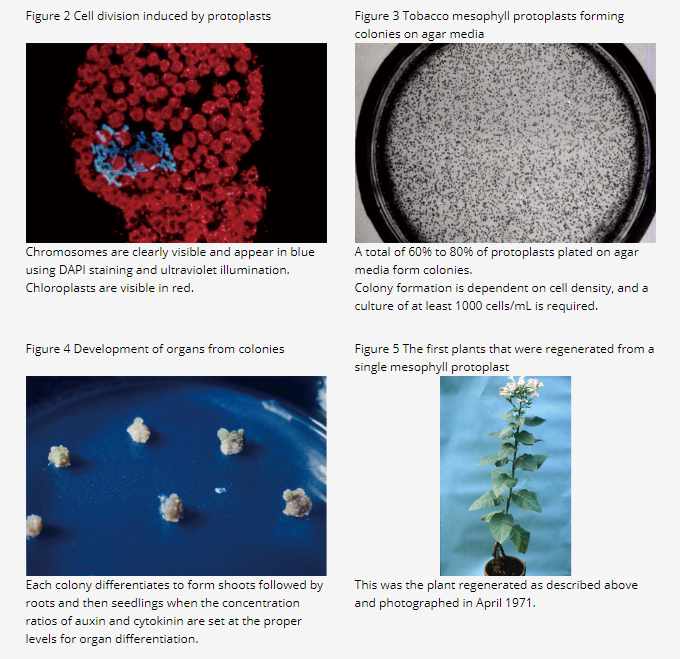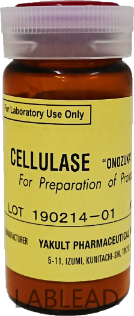产品说明书
| 产品说明书 | L0011-10g.doc |
CELLULASE “ONOZUKA”RS is produced by a mutant Trichoderma viride which was derived from the parent strain used for Cellulase “ONOZUKA”R-10.
CELLULASE “ONOZUKA”RS contains a very high activity of decomposing natural celluloses.
Also, protoplasts, which produced with Cellulase “ONOZUKA”RS are usually superior in the regeneration of the cell walls.
For laboratory uses.
PROPERTIES
Form: impalpable dry powder
Color: Yellowish white
Solubility: Readily soluble in water
Optimum pH: pH:4.0-5.0
Optimum temperature:50℃-60℃
Eylanase:CELLULASE “ONOZUKA”RS contains about three times as high xylanase activity as “ONOZUKA”R-10.
Activity:
CELLULASE “ONOZUKA”RS contains more than 16,000 units per gram of filter paper decomposing activity.
Plant regeneration from protoplasts
By the late 1960s many attempts had been made to culture isolated plant protoplasts, but without success.
The idea of culturing leaf cells can be traced to a proposal by Gottlieb Harberlandt at Linz, Austria, in 1902 6), but even in 1964, the monograph on cell and tissue culture authored by Philip R. White, a notable pioneer in this field, stated that it would be almost impossible to culture leaf cells 7). Nonetheless, Nagata and Takebe were ultimately able to isolate from the mesophyll of tobacco leaves and demonstrate unambiguously that not only were mesophyll protoplasts suitable for culture, but the process of cell division was synchronous when properly prepared starting materials were selected for culturing isolated tobacco mesophyll protoplasts 8). Cultured cell populations derived from tobacco mesophyll cells initiated DNA synthesis at 12 hours, started cell division at 24 hours (Figure 2), and cell division was completed in almost all cells by 72 hours. This created the possibility of culturing mesophyll protoplasts for cell biological studies of all kinds. Nagata and Takebe also demonstrated that proper selection of culture conditions and the use of agar media lead to colony formation at high frequency, indicating that higher plant cells can be handled almost like microorganisms (Figure 3).
After the colonies obtained from mesophyll protoplasts were transferred to conditions appropriate for organ differentiation, it was also shown for the first time that the regeneration of whole plants from any of these colonies is feasible (Figures 4 and 5). Although the totipotency of plant cells had been shown in the early 1960s, this culture system for tobacco mesophyll protoplasts was the first demonstration that the totipotency of somatic cells id almost 100% 9). This method was soon applied to plant regeneration from protoplasts obtained from potato leaves, and the obtained plants were reported to retain enough genetic diversity to be useful for the purposes of potato breeding 10). Since then, protoplasts have been prepared from a variety of plant species, and tissue studies and plant regeneration experiments have become a routine and extensively performed approach in the plant science research.
Around the same time as these key experiments, it was discovered that cell fusion can d be induced between plant protoplasts treated with polyethylene glycol, thereby leading to the beginning of a new area of“ somatic cell hybrid genetics.” The production of pomato and topato, which are somatic hybrids of potato and tomato 11), marked the beginning of plant biotechnology and a wide range of further developments 12). An overview of the growth of plant biotechnology research stemming from these advances can be found in many textbooks 13).

References
-
1)Küster, E.:Ber. Deutsch. Bot. Gesell. 27,589(1909)
-
2)Cocking, E.C. :Nature 187, 962(1960)
-
3)Takebe, I., Otsuki, Y., Aoki, S. :Plant Cell Physiol. 9, 115(1968)
-
4)Takebe, I., Otsuki, Y.:Proc. Natl. Acad. Sci. USA 84, 643(1969)
-
5)Fischer, E.P., Lipson, C.: Thinking about Science - Max Delbrück and the Origin of Molecular Biology, W.W. Norton & Co.(1988)
-
6)Harberlandt, G.:In:Plant Tissue Culture - 100 Years since Gottlieb Harberlandt, Laimer, M,, Rücker, W. (eds.), Springer-Verlag, Wien(2002)
-
7)White, P.R.: The Cultivation of Animal and Plant Cells, Ronald Press(1964)
-
8)Nagata, T., Takebe, I. :Planta 92, 201(1970)
-
9)Nagata, T., Takebe, I:Planta 99, 12(1971)
-
10)Melchers, G., Sacristán, M.D., Holder, A.A.:Carlsberg Res. Comm. 44, 127(1979)
-
11)Nagata, T., Bajaj, Y.P.S.(eds.): Biotechnology in Agriculture and Forestry, Vol. 49, Springer-Verlag, Heidelberg(2002)
-
12)Shephard, J., Bidney, D., Shahin, E. :Science 208, 17(1980)
-
13)Nagata, T., Cell Engineering of Plant Protoplasts, Kodansha Sci entific, Tokyo (1993) (in Japanese)
-
14)Nagata, T., Ishii, S. :Can. J. Bot. 57, 1820(1979)
-
15)Nagata, T., Nemoto, Y., Hasezawa, S.: Int. Rev. Cytol. 132, 1(1992)
-
16)Nagata, T., Okada, K., Takebe, I., Matsui, C. :Mol. Gen. Genet. 184, 161(1981)
-
17)Shimamoto, K., Terada, R., Izawa, T., Fujimoto, H. :Nature 338, 274(1989)
-
18)Hiei, Y., Komari, T., Kubo, T.: Plant Mol. Biol. 35, 205(1997)
-
19)Sonobe, S. :Protoplasma 155, 239(1990)
-
20)Komoda, K., Naito, S., Ishikawa, M.:Proc. Natl. Acad. Sci. USA 101, 1863(2004)
-
21)Okada, K., Nagata, T., Takebe, I.:Plant Cell Rep.7, 333(1988)


